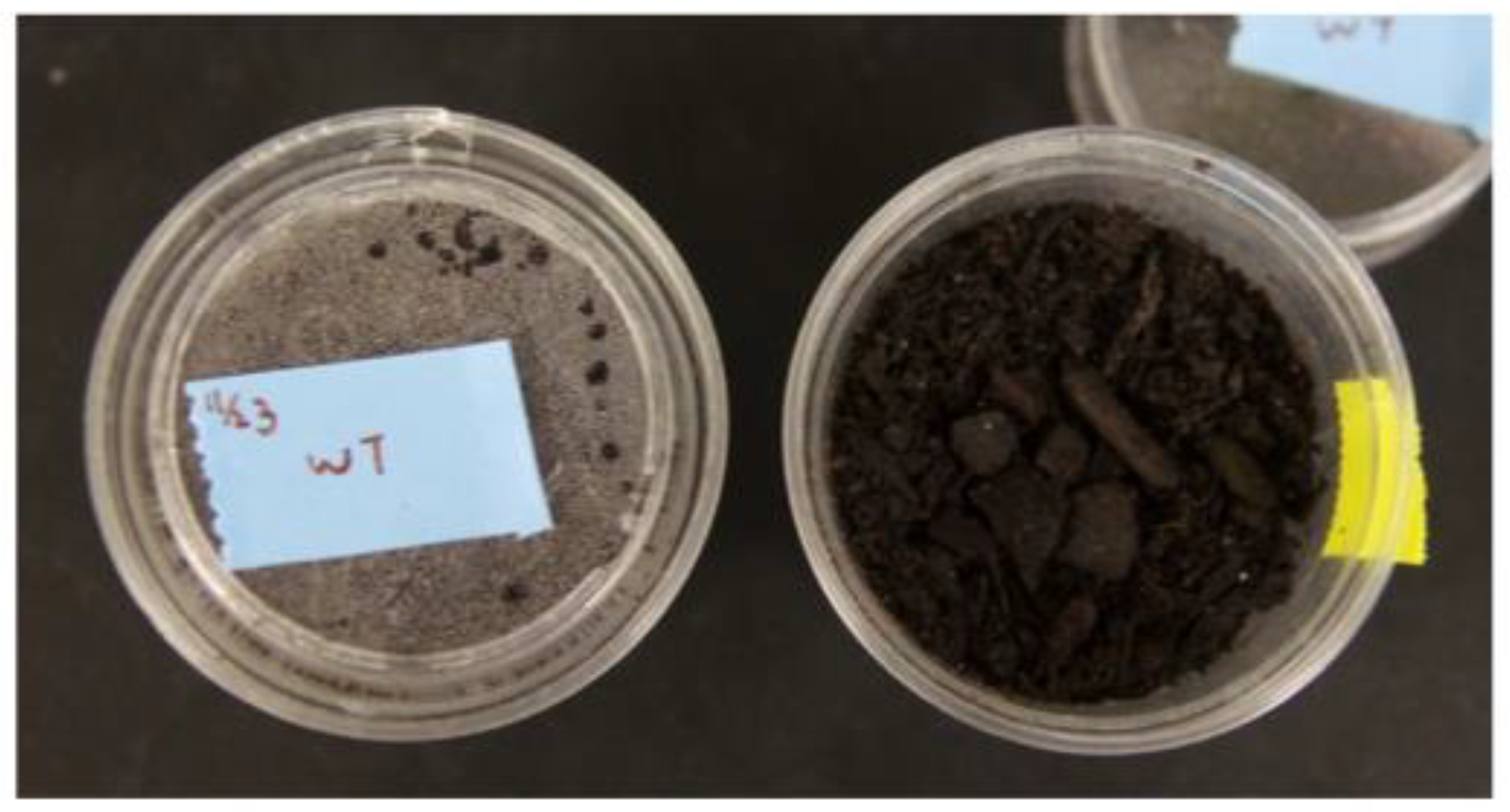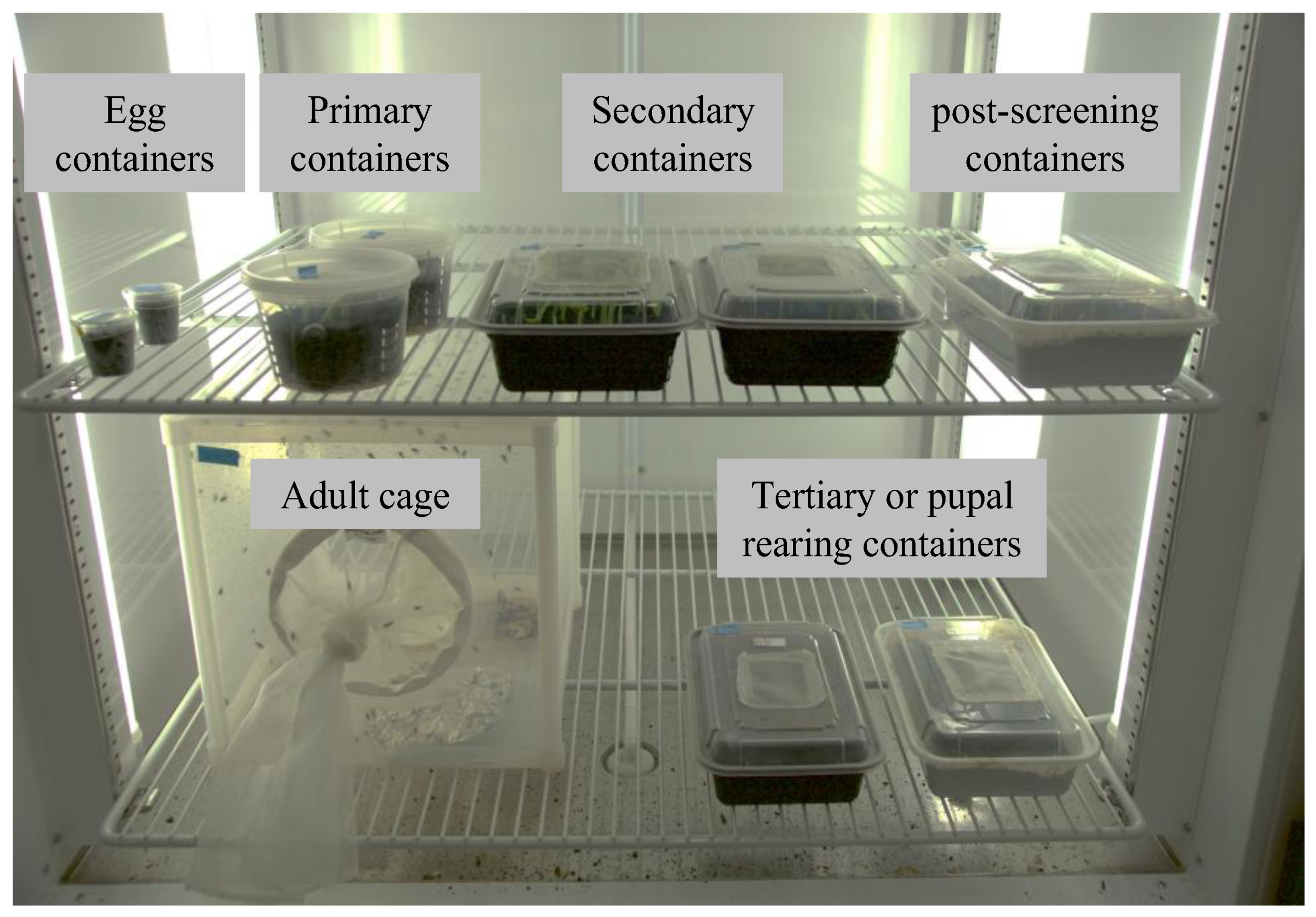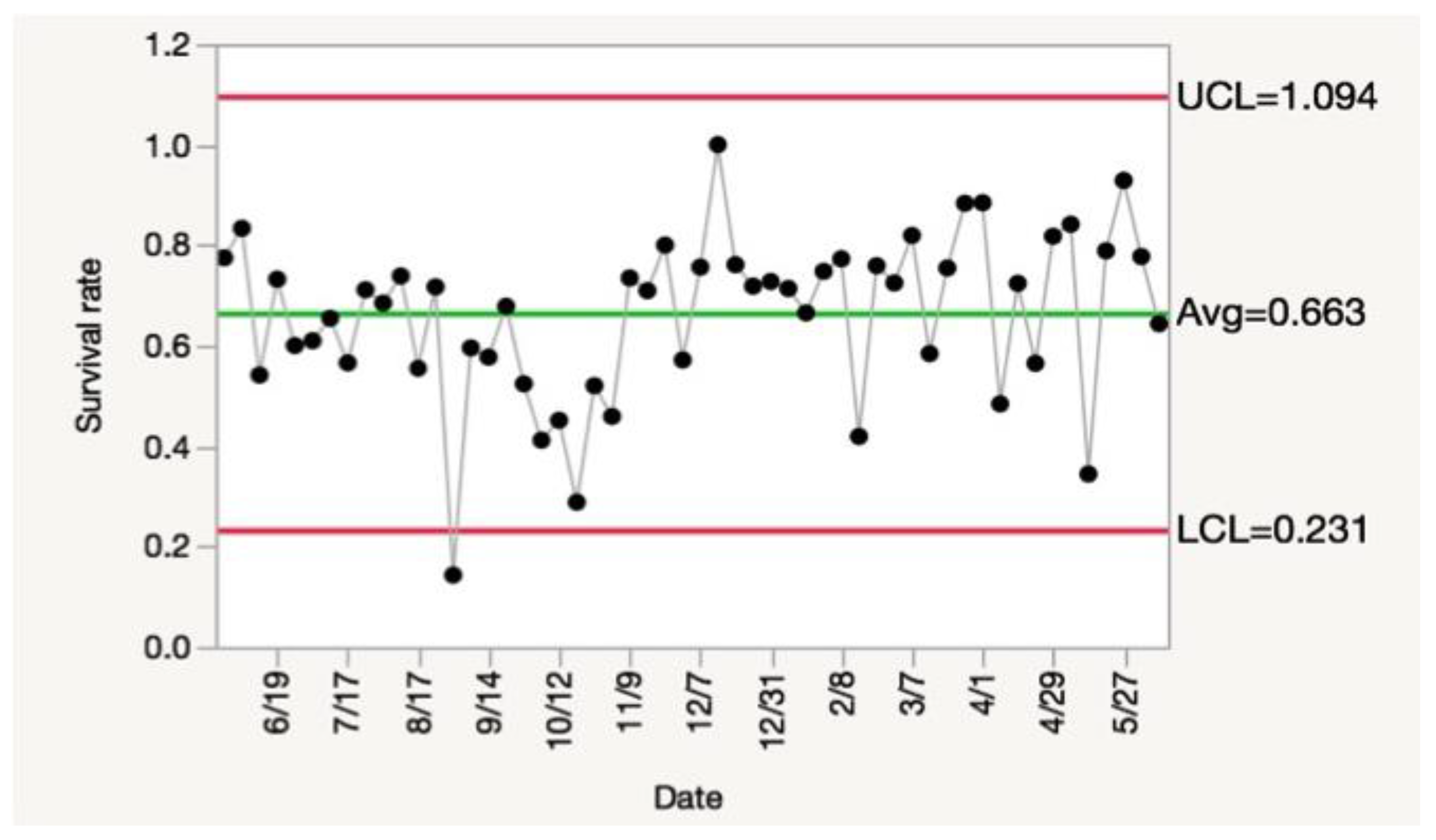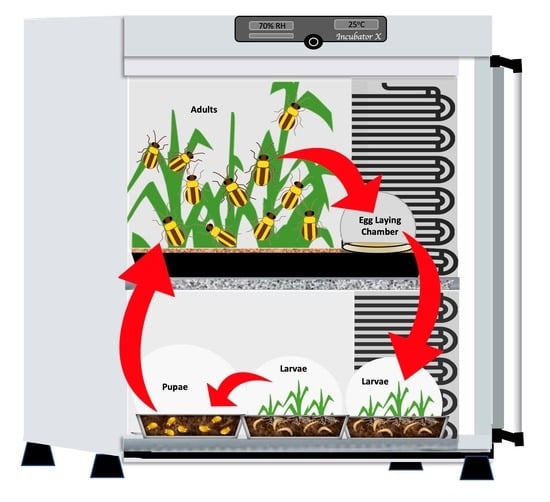An Optimized Small-Scale Rearing System to Support Embryonic Microinjection Protocols for Western Corn Rootworm, Diabrotica virgifera virgifera
Abstract
:Simple Summary
Abstract
1. Introduction
2. Materials and Methods
2.1. Source of Insect Strains
2.2. Details of the Rearing Protocol
2.2.1. Rearing Conditions
2.2.2. Preparation of Sprouted Corn
2.2.3. Single-Pair and Colony-Level Egg Laying
2.2.4. Egg Collection and Incubation
2.2.5. Preparing Primary Rearing Containers
2.2.6. Preparing Secondary and Tertiary Rearing Containers
2.2.7. Preparing Pupal Rearing Containers
2.2.8. Adult Collection for Colony- or Single-Pair Mating
2.3. Development Time, Eclosion Efficiency after Handling, and Quality Control
2.4. Fluorescent Light Screening
2.5. Single Pupae Handling and Survival Rate
2.6. Testing Single-Pair Mating Scheme
3. Results
3.1. Developmental Rate
3.2. Survival Rate
3.3. Quality Control System
3.4. Impact of Fluorescent Light Screening
3.5. Handling and Sexing Pupae
3.6. Single-Pair Crosses
4. Discussion
5. Conclusions
Supplementary Materials
Author Contributions
Funding
Data Availability Statement
Acknowledgments
Conflicts of Interest
References
- Gray, M.E.; Sappington, T.W.; Miller, N.J.; Moeser, J.; Bohn, M.O. Adaptation and invasiveness of western corn rootworm: Intensifying research on a worsening pest. Annu. Rev. Entomol. 2009, 54, 303–321. [Google Scholar] [PubMed] [Green Version]
- Georce, B.W.; Ortman, E.E. Rearing the western corn rootworm in the laboratory. J. Econ. Entomol. 1965, 58, 375–377. [Google Scholar] [CrossRef]
- Bigger, J.; March, R. Rearing southern corn rootworms on seedling corn plants. J. Econ. Entomol. 1943, 36, 349–350. [Google Scholar] [CrossRef]
- Branson, T.F.; Guss, P.; Krysan, J.; Sutter, G. Corn Rootworms: Laboratory Rearing and Manipulation; US Department of Agriculture, National Agricultural Library: Washington DC, USA, 1975.
- Branson, T.F.; Jackson, J.J.; Sutter, G.R. Improved method for rearing Diabrotica virgifera virgifera (Coleoptera, Chrysomelidae). J. Econ. Entomol. 1988, 81, 410–414. [Google Scholar] [CrossRef]
- Dominique, C.R.; Yule, W.N. Laboratory rearing technique for the northern corn rootworm, Diabrotica longicornis (Coleoptera, Chrysomelidae). Can. Entomol. 1983, 115, 569–571. [Google Scholar] [CrossRef]
- Jackson, J.; Davis, D. Rearing western corn rootworm larvae on seedling corn (Coleoptera: Chrysomelidae). J. Kans. Entomol. Soc. 1978, 353–355. [Google Scholar]
- Branson, T. The selection of a non-diapause strain of Diabrotica virgifera (Coleoptera: Chrysomelidae). Entomol. Exp. Appl. 1976, 19, 148–154. [Google Scholar] [CrossRef]
- Cohen, C.C. Insect Diets: Science and Technology, 2nd ed.; CRC Press: Boca Raton, FL, USA, 2015. [Google Scholar]
- Huynh, M.P.; Nielson, C.; Wade French, B.; Ludwick, D.C.; Geisert, R.W.; Pereira, A.E.; Barry, J.; Meihls, L.N.; Schneider, S.K.; Hibbard, B.E. Development of a nondiapausing strain of northern corn rootworm with rearing techniques for both diapausing and nondiapausing strains. Sci. Rep. 2021, 11, 17944. [Google Scholar] [CrossRef]
- Meinke, L.J.; Siegfried, B.D.; Wright, R.J.; Chandler, L.D. Adult susceptibility of Nebraska western corn rootworm (Coleoptera: Chrysomelidae) populations to selected insecticides. J. Econ. Entomol. 1998, 91, 594–600. [Google Scholar] [CrossRef] [Green Version]
- Miota, F.; Scharf, M.E.; Ono, M.; Marcon, P.; Meinke, L.J.; Wright, R.J.; Chandler, L.D.; Siegfried, B.D. Mechanisms of methyl and ethyl parathion resistance in the western corn rootworm (Coleoptera: Chrysomelidae). Pestic. Biochem. Physiol. 1998, 61, 39–52. [Google Scholar]
- Wright, R.J.; Scharf, M.E.; Meinke, L.J.; Zhou, X.G.; Siegfried, B.D.; Chandler, L.D. Larval susceptibility of an insecticide-resistant western corn rootworm (Coleoptera: Chrysomelidae) population to soil insecticides: Laboratory bioassays, assays of detoxification enzymes, and field performance. J. Econ. Entomol. 2000, 93, 7–13. [Google Scholar] [CrossRef] [PubMed] [Green Version]
- Gassmann, A.J.; Petzold-Maxwell, J.L.; Clifton, E.H.; Dunbar, M.W.; Hoffmann, A.M.; Ingber, D.A.; Keweshan, R.S. Field-evolved resistance by western corn rootworm to multiple Bacillus thuringiensis toxins in transgenic maize. Proc. Natl. Acad. Sci. USA 2014, 111, 5141–5146. [Google Scholar] [CrossRef] [PubMed]
- Meihls, L.N.; Higdon, M.L.; Siegfried, B.D.; Miller, N.J.; Sappington, T.W.; Ellersieck, M.R.; Spencer, T.A.; Hibbard, B.E. Increased survival of western corn rootworm on transgenic corn within three generations of on-plant greenhouse selection. Proc. Natl. Acad. Sci. USA 2008, 105, 19177–19182. [Google Scholar] [CrossRef]
- Branson, T.F.; Johnson, R.D. Adult western corn rootworms: Oviposition, fecundity, and longevity in the laboratory. J. Econ. Entomol. 1973, 66, 417–418. [Google Scholar] [CrossRef]
- Hill, R.E. Mating, oviposition patterns, fecundity and longevity of the western corn rootworm. J. Econ. Entomol. 1975, 68, 311–315. [Google Scholar] [CrossRef]
- Jackson, J.J. Rearing and handling of Diabrotica virgifera and Diabrotica undecimpunctata howardi. In Methods for the Study of Pest Diabrotica; Krysan, J.L., Miller, T.A., Eds.; Springer: New York, NY, USA, 1986; pp. 25–47. [Google Scholar]
- Lefko, S.A.; Nowatzki, T.M.; Thompson, S.D.; Binning, R.R.; Pascual, M.A.; Peters, M.L.; Simbro, E.J.; Stanley, B.H. Characterizing laboratory colonies of western corn rootworm (Coleoptera: Chrysomelidae) selected for survival on maize containing event DAS-59122-7. J. Appl. Entomol. 2008, 132, 189–204. [Google Scholar] [CrossRef]
- Krysan, J.L. Introduction: Biology, distribution, and identification of pest Diabrotica. In Methods for the Study of Pest Diabrotica; Krysan, J.L., Miller, T.A., Eds.; Springer: New York, NY, USA, 1986; pp. 1–23. [Google Scholar]
- Chu, F.-C.; Klobasa, W.; Wu, P.-S.; Pinzi, S.; Grubbs, N.; Gorski, S.; Cardoza, Y.; Lorenzen, M.D. Germline transformation of the western corn rootworm, Diabrotica virgifera virgifera. Insect Mol. Biol. 2017, 26, 440–452. [Google Scholar] [CrossRef] [PubMed]
- Chu, F.-C.; Wu, P.-S.; Pinzi, S.; Grubbs, N.; Lorenzen, M.D. Microinjection of western corn rootworm, Diabrotica virgifera virgifera, embryos for germline transformation, or CRISPR/Cas9 genome editing. J. Vis. Exp. 2018, 134, 57497. [Google Scholar]
- ODell, T.M. Straggling in gypsy moth production strains: A problem analysis for developing research priorities. In Advances in Insect Rearing for Research and Pest Management; Anderson, T.E., Ed.; CRC Press: Boca Raton, FL, USA, 1993; pp. 325–350. [Google Scholar]
- Odell, T.M.; Keena, M.A.; Willis, R.B. Dietary influence of iron formulation on the development of gypsy moth (Lepidoptera: Lymantriidae) in laboratory colonies. Annu. Rev. Entomol. 1997, 90, 149–154. [Google Scholar]
- Horn, C.; Offen, N.; Nystedt, S.; Häcker, U.; Wimmer, E. piggyBac-Based insertional mutagenesis and enhancer detection as a tool for functional insect genomics. Genetics 2003, 163, 647–661. [Google Scholar] [CrossRef]
- Cohen, C.C. Ecology of Insect Rearing Systems: A Mini-Review of Insect Rearing Papers from 1906–2017. Adv. Entomol. 2018, 6, 86–115. [Google Scholar] [CrossRef] [Green Version]
- Li, H.; Guillemaud, T.; French, B.W.; Kuhlmann, U.; Toepfer, S. Phenotypic trait changes in laboratory—Reared colonies of the maize herbivore, Diabrotica virgifera virgifera. Bull. Entomol. Res. 2014, 104, 97–115. [Google Scholar] [CrossRef] [PubMed] [Green Version]
- Cates, M.D. Behavioral and Physiological Aspects of Mating and Oviposition by the Adult Western Corn Rootworm, Diabrotica virgifera LeConte. Ph.D. Dissertation, The University of Nebraska-Lincoln, Lincoln, NE, USA, 1968. [Google Scholar]
- Branson, T.; Guss, P.; Jackson, J. Mating frequency of the western corn rootworm. Ann. Entomol. Soc. Am. 1977, 70, 506–508. [Google Scholar] [CrossRef]
- Klobasa, W.; Chu, F.C.; Huot, O.; Grubbs, N.; Rotenberg, D.; Whitfield, A.E.; Lorenzen, M.D. Microinjection of corn planthopper, Peregrinus maidis, embryos for CRISPR/Cas9 genome editing. J. Vis. Exp. 2021, 169, e62417. [Google Scholar]
- Dossey, A.T.; Oppert, B.; Chu, F.C.; Lorenzen, M.D.; Scheffler, B.; Simpson, S.; Koren, S.; Johnston, J.S.; Kataoka, K.; Ide, K. Genome and genetic engineering of the house cricket (Acheta domesticus): A resource for sustainable agriculture. Biomolecules 2023, 13, 589. [Google Scholar] [CrossRef] [PubMed]







| Stage | # of Insects | # of Adults | Survival Rate |
|---|---|---|---|
| Larvae | 3260 | 2675 | 82.06% |
| Pre/pupae 1 | 2184 | 1223 | 56.00% |
| Mix 2 | 2146 | 1586 | 73.90% |
| Total | 7590 | 5484 | 72.25% |
| Life Stage | # of Insects | # of Adults | Eclosion Rate |
|---|---|---|---|
| Larvae | 480 | 438 | 91.25% |
| Pre-pupae | 2630 | 1798 | 68.37% |
| Pupae | 4766 | 3950 | 82.88% |
| Pre/pupae | 818 | 652 | 79.71% |
| This Work | 1973 * | 1972 + | ||||
|---|---|---|---|---|---|---|
| Range | Mean | Range | Mean | Range | Mean | |
| Female longevity (days) | 31–132 | 78.4 ± 32.6 | 6–163 | 67.7 ± 30.6 | 19–126 | 94.8 ± 12.5 |
| No. eggs oviposited/female | 83–1070 | 414 ± 290.3 | 237–912 | 593.l ± 231.3 | 85–1913 | 1023 ± 240 |
| No. clutches/female | 3–17 | 8.1 ± 5 | 3–20 | 11.3 ± 5.4 | ||
| Avg no. eggs/clutch/female | 1–128 | 54.42 ± 25.7 | 39–79 | 56.9 ± 14.2 | ||
| Avg days between ovarian cycles | 1–11 | 4.63 ± 2.3 | 4.2–6.0 | 4.9 ± 0.4 | ||
| Preoviposition period (days) | 13–40 | 19.3 ± 8 | 11–19 | 15.3 ± 2.0 | ||
Disclaimer/Publisher’s Note: The statements, opinions and data contained in all publications are solely those of the individual author(s) and contributor(s) and not of MDPI and/or the editor(s). MDPI and/or the editor(s) disclaim responsibility for any injury to people or property resulting from any ideas, methods, instructions or products referred to in the content. |
© 2023 by the authors. Licensee MDPI, Basel, Switzerland. This article is an open access article distributed under the terms and conditions of the Creative Commons Attribution (CC BY) license (https://creativecommons.org/licenses/by/4.0/).
Share and Cite
Chu, F.-C.; Wu, P.-S.; Pinzi, S.; Grubbs, N.; Cohen, A.C.; Lorenzen, M.D. An Optimized Small-Scale Rearing System to Support Embryonic Microinjection Protocols for Western Corn Rootworm, Diabrotica virgifera virgifera. Insects 2023, 14, 683. https://doi.org/10.3390/insects14080683
Chu F-C, Wu P-S, Pinzi S, Grubbs N, Cohen AC, Lorenzen MD. An Optimized Small-Scale Rearing System to Support Embryonic Microinjection Protocols for Western Corn Rootworm, Diabrotica virgifera virgifera. Insects. 2023; 14(8):683. https://doi.org/10.3390/insects14080683
Chicago/Turabian StyleChu, Fu-Chyun, Pei-Shan Wu, Sofia Pinzi, Nathaniel Grubbs, Allen Carson Cohen, and Marcé D. Lorenzen. 2023. "An Optimized Small-Scale Rearing System to Support Embryonic Microinjection Protocols for Western Corn Rootworm, Diabrotica virgifera virgifera" Insects 14, no. 8: 683. https://doi.org/10.3390/insects14080683
APA StyleChu, F.-C., Wu, P.-S., Pinzi, S., Grubbs, N., Cohen, A. C., & Lorenzen, M. D. (2023). An Optimized Small-Scale Rearing System to Support Embryonic Microinjection Protocols for Western Corn Rootworm, Diabrotica virgifera virgifera. Insects, 14(8), 683. https://doi.org/10.3390/insects14080683









